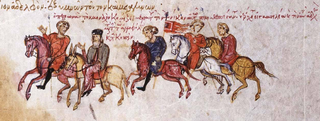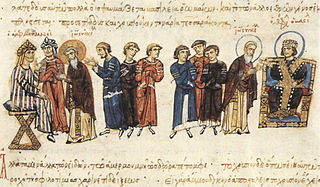
Heraclius, known by the diminutive Heraclonas or Heracleonas, and sometimes called Heraclius II, was briefly Byzantine emperor in 641.

Theophilos was Byzantine Emperor from 829 until his death in 842. He was the second emperor of the Amorian dynasty and the last emperor to support iconoclasm.

Michael III, also known as Michael the Drunkard, was Byzantine emperor from 842 to 867. Michael III was the third and traditionally last member of the Amorian dynasty. He was given the disparaging epithet the Drunkard by the hostile historians of the succeeding Macedonian dynasty, but modern historical research has rehabilitated his reputation to some extent, demonstrating the vital role his reign played in the resurgence of Byzantine power in the 9th century. He was also the youngest person to bear the imperial title, as well as the youngest to succeed as senior emperor.

Michael II, called the Amorian and the Stammerer, reigned as Byzantine emperor from 25 December 820 to his death on 2 October 829, the first ruler of the Amorian dynasty.

Tiberius III, born Apsimar, was Byzantine emperor from 698 to 705. Little is known about his early life, other than that he was a droungarios, a mid-level commander, who served in the Cibyrrhaeot Theme. In 696, Tiberius was part of an army sent by Byzantine Emperor Leontius to retake the North African city of Carthage, which had been captured by the Arab Umayyads. After seizing the city, this army was pushed back by Umayyad reinforcements and retreated to the island of Crete. As they feared the wrath of Leontius, some officers killed their commander, John the Patrician, and declared Tiberius the emperor. Tiberius swiftly gathered a fleet and sailed for Constantinople, where he then deposed Leontius. Tiberius did not attempt to retake Byzantine Africa from the Umayyads, but campaigned against them along the eastern border with some success. In 705, former emperor Justinian II, who had been deposed by Leontius, led an army of Slavs and Bulgars from the First Bulgarian Empire to Constantinople, and after entering the city secretly, deposed Tiberius. Tiberius fled to Bithynia, but was captured a few months later and beheaded by Justinian between August 705 and February 706. His body was initially thrown into the sea, but was later recovered and buried in a church on the island of Prote.

Theodora, sometimes called Theodora the Armenian or Theodora the Blessed, was Byzantine empress as the wife of Byzantine emperor Theophilos from 830 to 842 and regent for the couple's young son Michael III, after the death of Theophilos, from 842 to 856. She is sometimes counted as an empress regnant, exercising power in her own right, rather than just a regent. Theodora is most famous for bringing an end to the second Byzantine Iconoclasm (814–843), an act for which she is recognized as a saint in the Eastern Orthodox Church. Though her reign saw the loss of most of Sicily and failure to retake Crete, Theodora's foreign policy was otherwise highly successful; by 856, the Byzantine Empire had gained the upper hand over both the Bulgarian Empire and the Abbasid Caliphate, and the Slavic tribes in the Peloponnese had been forced to pay tribute, all without decreasing the imperial gold reserve.

The Battle of Anzen or Dazimon was fought on 22 July 838 at Anzen or Dazimon between the Byzantine Empire and the forces of the Abbasid Caliphate. The Abbasids had launched a massive expedition with two separate armies in retaliation for the Byzantine emperor Theophilos's successes the previous year, and aimed to sack Amorion, one of Byzantium's largest cities. Theophilos with his army confronted the smaller Muslim army, under the Iranian vassal prince Afshin, at Dazimon.

Petronas was a notable Byzantine general and leading aristocrat during the mid-9th century. Petronas was a brother of Empress Theodora and hence brother-in-law of Emperor Theophilos, under whom he advanced to the high court rank of patrikios and the post of commander of the Vigla guard regiment. After Theophilos' death, he played a role in the ending of Iconoclasm, but was sidelined along with his brother Bardas during the minority of his nephew, Michael III, when power was held by the regent Theoktistos. In 855, Petronas and Bardas encouraged Michael III to seize control of the government: Theoktistos was murdered, Theodora banished to a monastery, Bardas became Michael's chief minister, and Petronas was tasked with the war against the Arabs. In 863, he scored a crushing victory at the Battle of Lalakaon, a feat which marked the gradual beginning of a Byzantine counter-offensive in the East. Promoted to the rank of magistros and the office of Domestic of the Schools, he died in 865.

Theoktistos or Theoctistus was a leading Byzantine official during the second quarter of the 9th century and the de facto head of the regency for the underage emperor Michael III from 842 until his dismissal and murder in 855. A eunuch courtier, he assisted in the ascent of Michael II to the throne in 820, and was rewarded with the titles of patrikios and later magistros. He held the high posts of chartoularios tou kanikleiou and logothetēs tou dromou under Michael and his son Theophilos. After Theophilos' death in 842, Theoktistos became a member of the regency council, but soon managed to sideline the other members and establish himself as the virtual ruler of the Empire. Noted for his administrative and political competence, Theoktistos played a major role in ending the Byzantine Iconoclasm, and fostered the ongoing renaissance in education within the Empire. He also continued the persecution of the Paulician sect, but had mixed success in the wars against the Arabs. When Michael III came of age in 855, his uncle Bardas persuaded him to throw off the tutelage of Theoktistos and his mother, the Empress-dowager Theodora, and on 20 November 855, Theoktistos was assassinated by Bardas and his followers.

John VII of Constantinople, surnamed Grammatikos or Grammaticus, i.e., "the Grammarian", was Ecumenical Patriarch of Constantinople from 21 January 837 to 4 March 843, died before 867. He is not to be confused with the much earlier philosopher John Philoponus.
Bardanes, nicknamed Tourkos, "the Turk", was a Byzantine general who launched an unsuccessful rebellion against Emperor Nikephoros I in 803. Although a major supporter of Byzantine empress Irene of Athens, soon after her overthrow he was appointed by Nikephoros as commander-in-chief of the Anatolian armies. From this position, he launched a revolt in July 803, probably in opposition to Nikephoros's economic and religious policies. His troops marched towards Constantinople, but failed to win popular support. At this point, some of his major supporters deserted him and, reluctant to engage the loyalist forces in battle, Bardanes gave up and chose to surrender himself. He retired as a monk to a monastery he had founded. There he was blinded, possibly on Nikephoros's orders.
Alexios Mosele or Musele/Mousele (Μουσελέ) was a Byzantine aristocrat and general, chosen by Emperor Theophilos for a time as his heir, betrothed to his daughter Maria and raised to the supreme dignity of Caesar. He campaigned in the Balkans, recovering territory from the Slavs, and fought with some success in Sicily against the Arabs. Recalled to Constantinople on suspicion of plotting to usurp the throne, he was imprisoned but later pardoned and allowed to retire to a monastery, where he spent the remainder of his days.
Manuel the Armenian, was a prominent Byzantine general of Armenian origin, active from c. 810 until his death. After reaching the highest military ranks, a palace conspiracy forced him to seek refuge in the Abbasid court in 829. He returned to Byzantine service the next year, receiving the position of Domestic of the Schools from Emperor Theophilos, who had married his niece Theodora. Manuel remained in the post throughout Theophilos's reign, and reportedly saved the emperor's life in the Battle of Anzen in 838. According to one report, he died on 27 July 838 of wounds received during the battle, but other sources record his survival past this date, ascribing him a major role in the regency that governed the empire after Theophilos's death, and report that he died some time around 860.

Symbatios, variously also Sabbatios (Σαββάτιος) or Sambates (Σαμβάτης) in some sources, was the eldest son of the Byzantine emperor Leo V the Armenian. Soon after the coronation of his father, he was crowned co-emperor and renamed Constantine. He reigned nominally along with his father until the latter's assassination in 820, after which he was exiled to Prote, one of the Princes' Islands, as a monk.

Saint Nicetas the Patrician was a Byzantine monk and a fervent opponent of Byzantine Iconoclasm. He is usually identified with Nicetas Monomachos, a eunuch official and general from Paphlagonia active at the turn of the 9th century.
Sergios Niketiates was a senior Byzantine official and member of the Amorian dynasty. He is celebrated as a saint by the Eastern Orthodox Church on 28 June for his role in the restoration of the veneration of icons.

Euthymius of Sardis or Euthymius the Confessor was metropolitan bishop of Sardis between ca. 785 and ca. 804, and a leading iconophile during the period of Byzantine Iconoclasm. Martyred in 831, he is a saint in the Eastern Orthodox Church, celebrated on 26 December and March 8.

Theoktiste, also known as Phlorina (Φλώρινα), was the mother of the 9th-century Byzantine empress Theodora, the wife of Emperor Theophilos.

Thekla, Latinized as Thecla, was a princess of the Amorian dynasty of the Byzantine Empire. The eldest child of Byzantine emperor Theophilos and empress Theodora, she was proclaimed augusta in the late 830s. After Theophilos's death in 842 and her mother becoming regent for Thekla's younger brother, Michael III, Thekla was associated with the regime as co-empress alongside Theodora and Michael.

The Amorian dynasty ruled the Byzantine Empire from 820 to 867. The Amorian dynasty continued the policy of restored iconoclasm started by the previous non-dynastic emperor Leo V in 813, until its abolition by Empress Theodora with the help of Patriarch Methodios in 842. The continued iconoclasm further worsened relations between the East and the West, which were already bad following the papal coronations of a rival line of "Roman Emperors" beginning with Charlemagne in 800. Relations worsened even further during the so-called Photian Schism, when Pope Nicholas I challenged Photios' elevation to the patriarchate. However, the era also saw a revival in intellectual activity which was marked by the end of iconoclasm under Michael III, which contributed to the upcoming Macedonian Renaissance.















